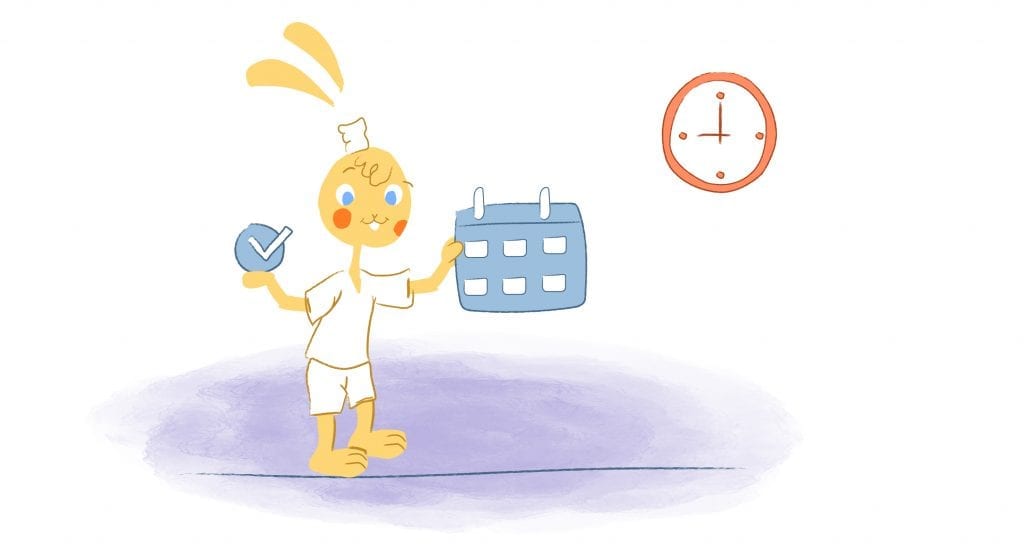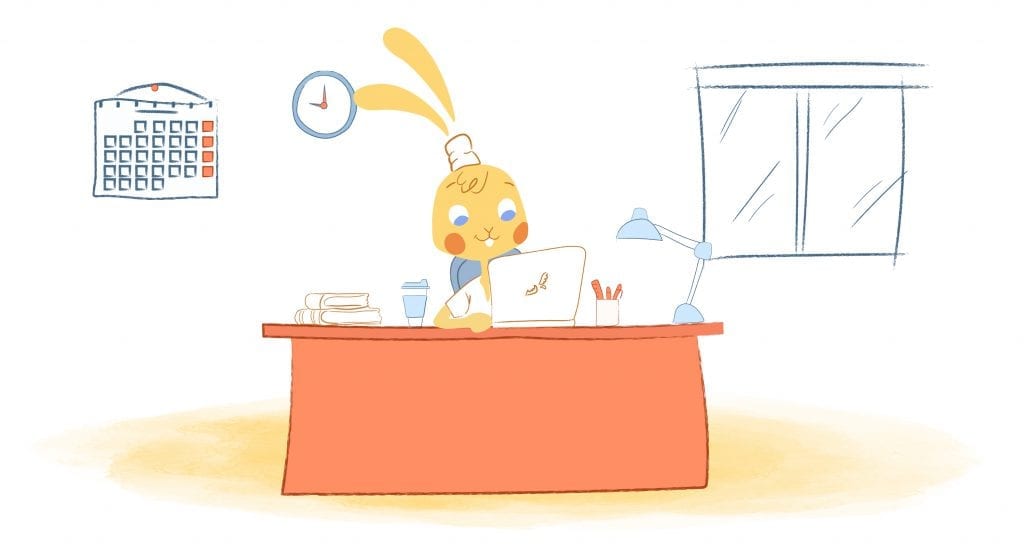

If you’re reading this article, then it’s safe to say that you want to become a more productive person. After all, it’s been found that 40 percent of the time we spend at work is unproductive.
For the other 60 percent, how are they able to be productive? Well, they follow a routine and have found their own habits and strategies to get more done in less time. And, they probably schedule their days like this….
Start with a morning ritual.
After studying the schedules of high-achievers, Laura Vanderkam writes in her book “What the Most Successful People Do Before Breakfast” that they all have a morning ritual.
Morning routines can vary from person to person. But here’s some examples of how the most successful people in the world spend their mornings:
- Elon Musk spends 30-minutes going through “critical emails,” grabs a cup of coffee, showers, and heads into the office.
- Mark Zuckerberg doesn’t wake-up too early. But, when he does, his routine involves working out or running, eating breakfast, getting dressed, and heading over to Facebook headquarters.
- When Oprah wakes-up she brushes her teeth, walks her dogs, works out, meditates, eats a healthy breakfast, and goes over her schedule for the day.
- Arianna Huffington doesn’t use an alarm clock. In fact, she doesn’t look at phone until she’s done practicing mindfulness for a couple of minutes.
- Richard Branson rises at five am — gets in some cardio through tennis or running, and eats breakfast with his family. He then checks his emails and reads the news.
- Tony Robbins doesn’t have a set wake-up time. But, when he does get up he jumps into a pool or into a cryotherapy tank. He then practices mindfulness and consumes a protein-heavy breakfast.
- Jeff Bezos also doesn’t rely on alarm clocks. After waking-up naturally, he has breakfast with his wife and blocks out his schedule.
Creating a morning routine.
As you can see, there is no exact morning ritual that productive people follow. It’s all about starting your day on the right foot. However, it you’re looking to create your own morning routine here’s a couple of pointers to get started:
- Wake-up before everyone else. This gives you a chance to email, read, write, meditate, or plan out your day without being distracted.
- Exercise, meditate, and eat healthy. This should be common sense. But, laying in bed and eating donuts won’t give you the energy to make it through the day.
- Set goals for the day. As noted in “The 100 Simple Secrets of Successful People,” “People who construct their goals in concrete terms are 50 percent more likely to feel confident they will attain their goals and 32 percent more likely to feel in control of their lives.”
- Review your calendar. This way you know what to expect for the day. Also, it ensures that you can address any scheduling conflicts before it’s too late.
- Spend time doing something you love. This could be eating breakfast, walking your dog, or working on a hobby. It puts things in perspective. It also puts you in a good mood.
Focus on three big tasks for the day — starting with your frog.
If you’re constantly putting out fires or working on smaller tasks, you’re not going to ever be able to work on your larger goals.
Whether you do this the night before or in the morning, list your three big and most important tasks for the day. These should be at the top of your to-do-list. You should base your schedule around these three tasks and eliminate all distractions.
For example, if you block out from 9am to 11am in your calendar to work on your first big task, then turn-off your phone and all notifications from email or social media. If you don’t have an office with a door, put on a pair of noise-cancelling headphones. You may also want to work somewhere else like a coffee shop.
Not sure which task to start with? I suggest you start with eating the frog first.
This isn’t literally eating a frog. It’s actually the thing that you don’t want to do, but absolutely need to get done. You may not want to do this task because it’s challenging or unpleasant. But, if you don’t complete it, it will linger with you all day.
However, if you just go ahead and eat the frog first thing in the morning the rest of the day will much easier and productive. Not only do you feel like a weight has been lifted off your shoulders, you also feel accomplished. And you can now use that momentum to cross-off the remaining two tasks you planned for the day.
Take the middle of the day off.
The world’s most productive persons — plan their work schedules around when they’re most productive. That means if you’re a night owl, then waking-up at dawn may be counterproductive. However, since most people are more productive in the morning, specifically a couple of hours after they’ve woken-up, it’s not a bad idea to take the middle of the day off.
Evan Williams, the co-founder of Twitter and Medium, workouts out during the middle of the day.
“I used to go to the gym first thing in the morning. Exercise is, of course, great for energy levels and I believe it makes me more productive no matter what. But energy and focus naturally ebb and flow throughout the day,” explains Williams.
“My focus is usually great first thing in the morning, so going to the gym first is a trade off of very productive time. Instead, I’ve started going mid-morning or late afternoon (especially on days I work late). It feels weird (at first) to leave the office in the middle of the day, but total time spent is nearly the same with higher energy and focus across the board.”
Business Insider’s Alexa Pipia also tried out exercising in the middle of the day. Pipa found that she was more productive in the morning, took fewer breaks throughout the day, and drank less coffee.
Schedule calls and meetings in the afternoon.
Thanks to our natural circadian rhythm, we all tend to experience afternoon brain fog.
Instead of trying to fight it, grab a snack and take a power nap if possible. Next, review your goals and the progress that you’ve already made so far. This can give you the motivation the get through the rest of the day.
Speaking of which. Because your energy is not at high in the afternoon, you should spend busy work instead of more creative and challenging work. This means working on soft tasks like returning calls and attending meetings. In fact, 3pm has been found to be the best time for meetings.
Follow the 52-17 rule.
We’re not robots! We all need to take frequent breaks throughout the day in order to stay fresh and operate at a high capacity. This is why so many people have embraced the Pomodoro Technique.
However, after tracking the habits of their top 10 percent most productive users, Desktop found that the ideal average for success is 52 minutes of work followed by 17 minutes of rest.
Even if you don’t work for 52 minutes exactly, the idea is that you need breaks to recharge, refocus, and avoid burnout.
Create theme days.
Jack Dorsey, CEO of Twitter and Square, spends 8-hours per day at each company. How on Earth can he productive then?
“The only way to do this is to be very disciplined and very practiced and the way I found that works for me is I theme my days,” explains Dorsey.
“So on Monday at both companies I focus on management and running the company which is—we have our directional meeting at Square and we have our OpCom meeting at Twitter. I do all my management one-on-ones on that day,” he adds.
“Tuesday is focused on product. Wednesday is focused on marketing and communications and growth. Thursday is focused on developers and partnerships and Friday is focused on the company and the culture and recruiting.”
Dorsey takes Saturday off and goes hiking. He uses Sunday to reflect and plan for the upcoming week.
The reason why these theme days are so effective is because it keeps Dorsey focused. And, if he is interrupted, he can quickly deal with it and jump right back into what he was working-on.
Avoid decisions.
Have you wondered why Mark Zuckerberg, Barack Obama, and Steve Jobs always wore the same outfits? It’s not because they were lazy or lacked fashion sense. They were simply reserving their mental energy.
It turns out that as the day goes on, the ability to make smart decisions decreases. By making fewer decisions on something like an outfit, productive people are preventing decision fatigue.
Productive people avoid decision fatigue by automating and streamlining as many non-essential decisions as possible. This could be laying out your clothes before bed, making all of your meals on Sunday, and using calendar software to automatically schedule meetings.
Batch tasks together.
I know that there are some people you can write a blog post while talking on the phone.
That’s incredibly impressive considering that multitasking reduces the quality of your work. The reason? Because you’re switching attention between tasks, you’re not giving 100 percent of your focus to each task. In fact, the University of Michigan found that productivity decreases by 40 percent when people attempted to do two or more things at once.
Additional research from Stanford also shows that multitaskers may be a price cognitively.
Instead of multitasking, try batching.
This is where you group similar tasks together and work on them during one chunk of time. For example, this could be making all of your phones in an hour block of time or cranking out all of your content in the same afternoon.
Keep your routine flexible.
While a schedule can keep you focused and organized, you don’t want to block out every since hour of the day. That’s why some productive and successful people opt to schedule in white space in their calendars. Begin scheduling in white space and see a whole new you.
White space is just time that you set aside throughout the day where you reflect, meditate, or just catch your breath. I know what you’re thinking. “But, I don’t have any time in my hectic schedule to do nothing!”
One way around this is when you schedule a meeting that last for 30-minutes, block out 40-minutes in your calendar. This way you have 10 minutes before or after the meeting to whatever you like. It’s a tactic that’s been used by LinkedIn CEO Jeff Weiner and Jeff Bezos.
Another option is keep entire days open. Tim Ferriss, for example, doesn’t plan much on Mondays and Fridays.
“I ask my assistants to avoid phone calls on Mondays and Fridays, in case I want to take a long weekend on either end, and I almost always allocate Mondays for general preparation and prioritizing for the week, then any administrative tasks that I need to handle (paperwork for accountants, lawyers, etc.),” writes Ferriss.
“I don’t have to do anything in this schedule. Instead Ferriss says, “I choose to do them because I like them.” He adds, “None of them are financially-driven or unpleasant obligations. If the chance to do something more fun comes up last-minute, I can cancel all of them.”
Relax in the evening.
Even though productive people have had a busy and fulfilling, they also tend to take the evenings off. The reason? It gives them a chance to recharge for tomorrow.
But, what exactly do they do when they’re not working? They relax and enjoy activities that reduce stress.
“According to the American Psychological Association, the most effective stress-relief strategies are exercising or playing sports, praying or attending a religious service, reading, listening to music, spending time with friends or family, getting a massage, going outside for a walk, meditating or doing yoga, and spending time with a creative hobby. (The least effective strategies are gambling, shopping, smoking, drinking, eating, playing video games, surfing the Internet, and watching TV or movies for more than two hours.)”
After that, they go to bed at a set time and get plenty of sleep — usually 6-8 hours.











Albert Costill
My name is Albert Costill and I'm a content marketer at Calendar. If I can help people become more productive in my journey, even better. If you ever have a question about your Calendar or how you can use it - - don't hesitate to reach out. I'm a Calendar Pro.